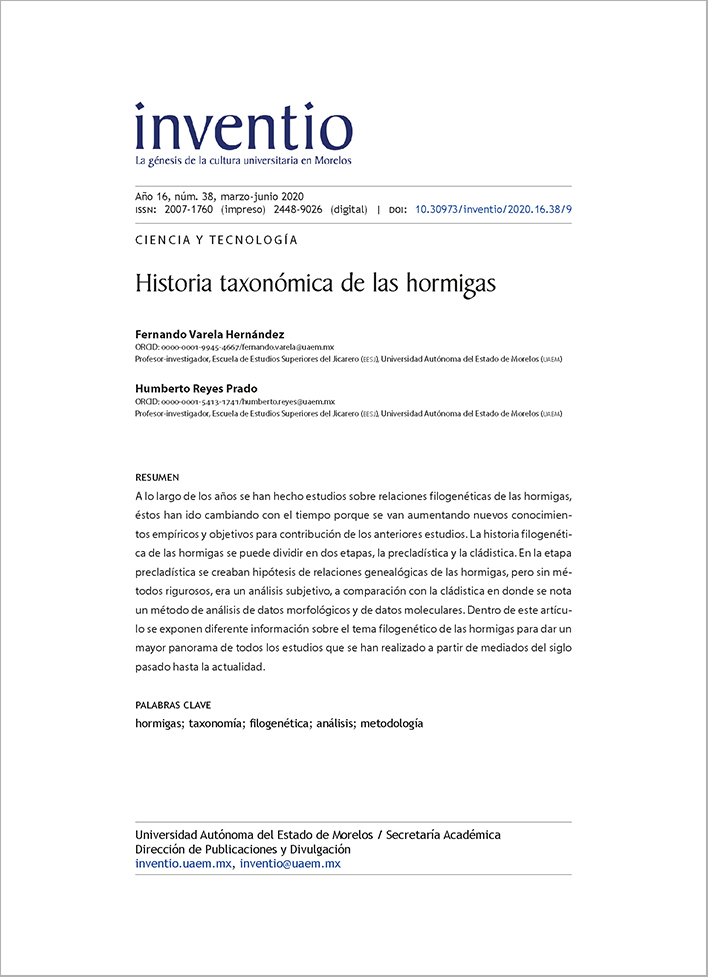Historia taxonómica de las hormigas
DOI:
https://doi.org/10.30973/inventio/2020.16.38/9Palabras clave:
hormigas, taxonomía, filogenética, análisis, metodologíaResumen
A lo largo de los años se han hecho estudios sobre relaciones filogenéticas de las hormigas, éstos han ido cambiando con el tiempo porque se van aumentando nuevos conocimientos empíricos y objetivos para contribución de los anteriores estudios. La historia filogenética de las hormigas se puede dividir en dos etapas, la precladística y la cládistica. En la etapa precladística se creaban hipótesis de relaciones genealógicas de las hormigas, pero sin métodos rigurosos, era un análisis subjetivo, a comparación con la cládistica en donde se nota un método de análisis de datos morfológicos y de datos moleculares. Dentro de este artículo se exponen diferente información sobre el tema filogenético de las hormigas para dar un mayor panorama de todos los estudios que se han realizado a partir de mediados del siglo pasado hasta la actualidad.
Citas
Baroni Urbani, C. (1989). Phylogeny and behavioral evolution in ants, with a discussion of the role of behavior in evolutionary processes, Ethology, Ecology and Evolution, 1, 137-168.
Baroni Urbani, C., Bolton, B. y Ward, P. S. (1992). The internal phylogeny of ants (Hymenoptera: Formicidae), Systematic Entomology, 17, 301-329.
Bolton, B. (1990). Army ants reassesed: The phylogeny and classification of the doryline section (Hymenoptera:Formicidae). Journal of Natural History, 24, 1339-1364.
Brady, S. G., Schultz, T. R., Fisher, B. y Ward, P. S. (2006). Evaluating alternative hypothesis for the early evolution and diversification of ants. Proceedings of the National Academy of Sciences, 103(48), 18172-18177.
Brown Jr, W. L. (1954). Remarks on the internal phylogeny and subfamily classification of the family Formicidae. Insectes Sociaux, 1, 21-31.
Carpenter, J. M. (1990). On Baroni Urbani’s ant phylogeny. Notes From Underground, 3, 6-8.
Astruc, C., Julien, J.-F., Errard, C. y Lenoir, A. (2004). Phylogeny of ants (Formicidae) based on morphology and sequence data. Molecular Phylogenetics and Evolution, 31, 880-893.
Dlusskyi, G. M. y Fedoseeva, E. B. (1988). Origin and early evolution of the ants. Cretaceous Biocenotic Crisis and Insect Evolution, 70.
Fernández, F. (2003). Sistemática y filogenia de las hormigas: breve repaso a propuestas. Introducción a las hormigas de la región Neotropical. Instituto de Investigaciones de Recursos Biológicos Alexander Von Humboldt.
Hermann, H. R. (1969). The hymenopterous poison apparatus: evolutionary trends in three closely related subfamilies of ants (Hymenoptera: Formicidae). Journal of the Georgia Entomological Society, 4, 123-141.
Keller, R. A. (2011). A phylogenetic analysis of ant morphology (Hymenoptera: Formicidae) with special reference to the poneromorph subfamilies, Bulletin of the American Museum of Natural History, 355, 1-90.
Moreau, C., Bell, C. D., Vila, R., Archibald, B. y Pierce, N. E. (2006). Phylogeny of the ants: diversification in the age of angiosperms. Science, 32, 101-104.
Moreau, C. y Bell, C. D. (2013). Testing the museum versus cradle tropical biological diversity hypothesis: phylogeny, diversification and ancestral biogeographic range evolution of the ants. Evolution, 67, 2240-2257.
Ohnishi, H., Hirotami, I. y Masa-Toshi, Y. (2003). Molecular phylogenetic analysis of ant subfamily relationship inferred from rDNA sequences. Genes and Genetic Systems, 78, 419-425.
Rabeling, C., Brown, J. M. y Verhaagh, M. (2008). Newly discovered sister lineage sheds light on early ant evolution. Proceedings of the National Academy of Sciences, 205, 14913-14917.
Taylor, R. W. (1978). Nothomyrmecia macrops: a living fossil ant rediscovered. Science, 201, 1978, 979-985.
Ward, S. P. (2007). Phylogeny, classification, and species-level taxonomy of ants (Hymenoptera: Formicidae). Zootaxa, 1668, 549-563.
Ward, P. S. (2014). The phylogeny and evolution of ants. The Annual Review of Ecology, Evolution and Systematics, 45, 23-43.
Ward, P. S., Brady, S. G., Fisher, B. L. y Schultz, T. R. (2014). The evolution of myrmicine ants: phylogeny and biogeography of a hyperdiverse ant clade (Hymenoptera: Formicidae). Systematic Entomology, 40, 61-81.
Ward, P. S., Blaimer, B. B. y Fisher, B. L. (2016). A revised phylogenetic classification of the ant subfamily Formicinae (Hymenoptera: Formicidae), with resurrection of the genera Colobopsis and Dinomyrmex. Zootaxa, 4072, 343-357.
Wilson, O. E., Carpenter, M. E., y Brown Jr., W. L. (1967). The first Mesozoic ants. Science, 157, 1038-1040.

Publicado
Cómo citar
Número
Sección
Licencia
Derechos de autor 2021 Fernando Varela Hernández, Humberto Reyes Prado

Esta obra está bajo una licencia internacional Creative Commons Atribución-NoComercial 4.0.
Esta revista proporciona acceso abierto inmediato a su contenido, con base en el principio de ofrecer al público un acceso libre a las investigaciones para contribuir a un mayor intercambio global de conocimientos. Se distribuye bajo una licencia Creative Commons Reconocimiento-NoComercial 4.0 Internacional License.

